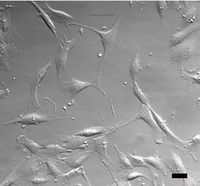Hoffman modulation contrast microscopy

Hoffman modulation contrast microscopy is a special type of microscope that allows us to see tiny things more clearly than normal microscopes. Think of it like having a magnifying glass, but with even more detail!
Normally, microscopes work by shining light through a sample and then using lenses to focus that light onto a camera or your eye. This can be useful for seeing certain things like cells or bacteria, but sometimes it's difficult to see details clearly because they are too small or too transparent.
That's where Hoffman modulation contrast microscopy comes in! Instead of just shining light through the sample, this microscope changes the way the light interacts with the sample so that we can see tiny structures more easily.
The microscope has a special lens called a Hoffman modulator that splits the light into two different beams. One beam goes directly through the sample, while the other beam is deflected slightly to the side. These two beams are then recombined, or "modulated," which creates a contrast between the different parts of the sample.
This contrast makes it easier to see small details like the edges of cells or the outlines of organelles. It's kind of like how a shadow can make a picture more detailed because it creates contrast between different parts of the image.
So, in summary, Hoffman modulation contrast microscopy is a type of microscope that uses a special lens to create contrast between different parts of a sample, which makes it easier to see tiny structures more clearly.
Normally, microscopes work by shining light through a sample and then using lenses to focus that light onto a camera or your eye. This can be useful for seeing certain things like cells or bacteria, but sometimes it's difficult to see details clearly because they are too small or too transparent.
That's where Hoffman modulation contrast microscopy comes in! Instead of just shining light through the sample, this microscope changes the way the light interacts with the sample so that we can see tiny structures more easily.
The microscope has a special lens called a Hoffman modulator that splits the light into two different beams. One beam goes directly through the sample, while the other beam is deflected slightly to the side. These two beams are then recombined, or "modulated," which creates a contrast between the different parts of the sample.
This contrast makes it easier to see small details like the edges of cells or the outlines of organelles. It's kind of like how a shadow can make a picture more detailed because it creates contrast between different parts of the image.
So, in summary, Hoffman modulation contrast microscopy is a type of microscope that uses a special lens to create contrast between different parts of a sample, which makes it easier to see tiny structures more clearly.
